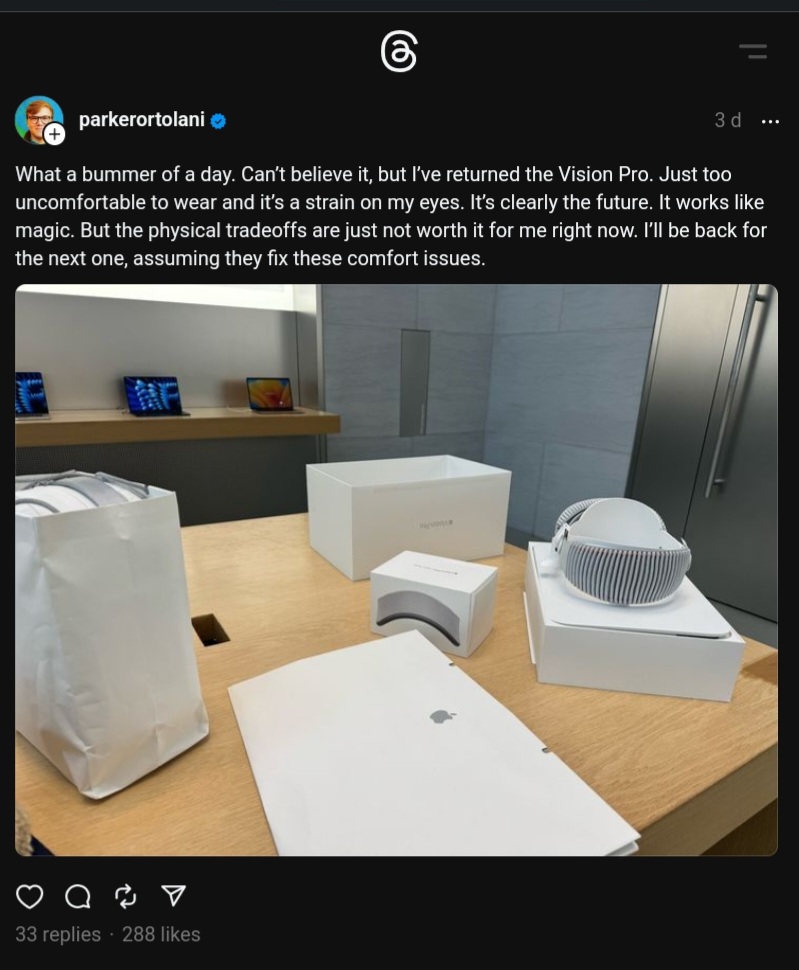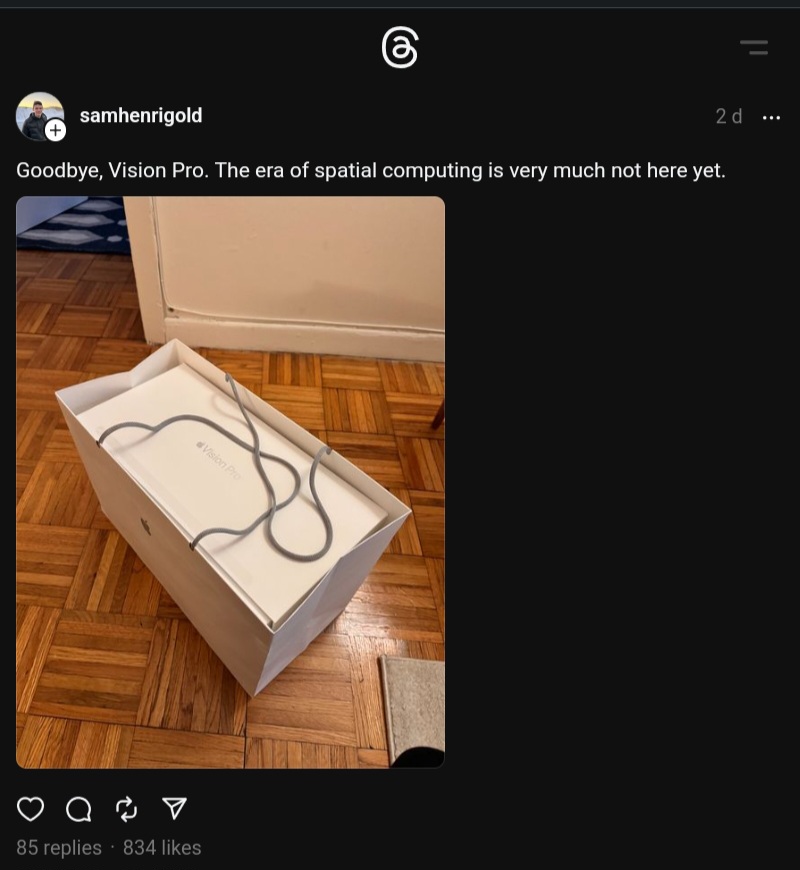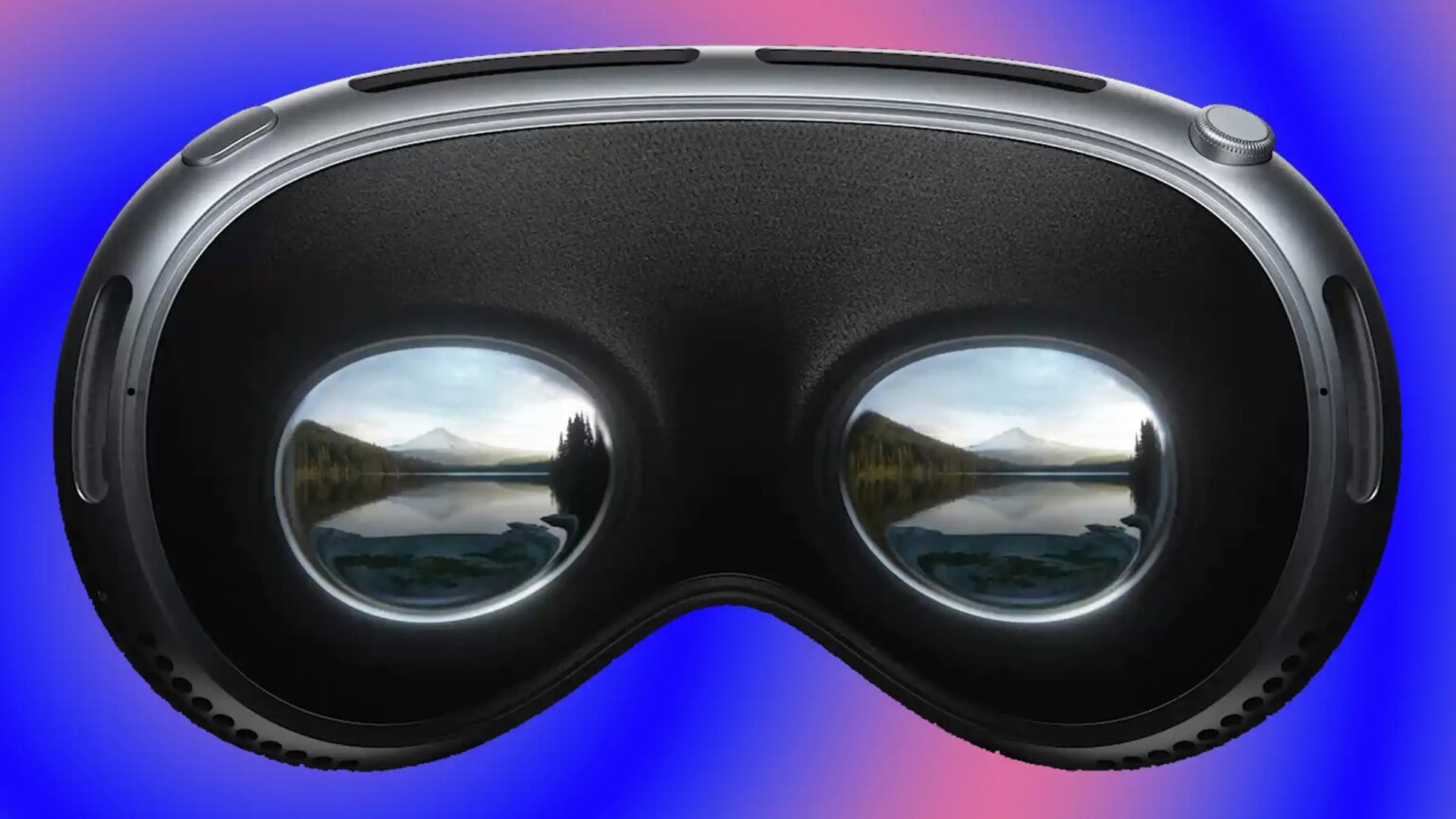Apple’s dream virtual and augmented reality headset Vision Pro is becoming a nightmare for some people. Early users reported getting sick after using the $3,500 device and have now started returning it to the company for a refund.
People complained that the headsets were uncomfortable and gave them headaches and motion sickness each time they put them on, according to several social media posts.
Others said Vision Pro caused them eye problems, including a “burst blood vessel,” and neck fatigue because, at 650 grams, the device was “too heavy [and] unweildly.”
Users also reported that the hardware did not help improve productivity at work and felt they weren’t getting value for their money. Some people have since returned their Vision Pros to Apple, which allows dissatisfied customers to return goods within 14 days of purchase.
Also read: Apple’s Vision Pro Sold 180,000 Units in Pre-orders but Device is Still ‘Very Niche’
Goodbye, Vision Pro!
The Vision Pro, which Apple prefers to call a spatial computer, sold out within hours of pre-orders opening on Jan. 17. Analyst Ming-Chi Kuo estimates that Apple sold 180,000 units of the headset at the time, but other reports suggest it could be more.
Deliveries started on Feb. 2, and two weeks into the product’s life, some users are already questioning whether the headset is ready for the market. Parker Ortolani, a product manager and early enthusiast of Vision Pro, said he returned the device because it was “just too uncomfortable to wear, and it’s a strain on my eyes.”
“The physical tradeoffs are just not worth it for me right now. I’ll be back for the next one, assuming they fix these comfort issues,” he wrote on Threads. Ortolani later told The Verge that the Vision Pro is “too expensive” and that it is “uncomfortable to wear even for short periods of time, both due to the weight and the strap designs.”

Motion sickness is induced by wearable technology and triggered by a “discrepancy” between the body’s sensory signals.
According to research, cybersickness varies based on immersion, with users exposed to augmented reality for a long time displaying oculomotor disturbances (headache, dizziness, etc.). As opposed to virtual reality, which primarily causes disorientation.
Another user posting on Threads said, “Goodbye, Vision Pro! The era of spatial computing is very much not here yet.”
“I really needed this to be a multi-purpose device to justify its price—the absolute best entertainment experience and a killer productivity device,” the person, Sam Henri Gold, detailed.
“I don’t feel like it satisfied either any better than my old-world devices could. I don’t really use my iPad; I always end up grabbing my laptop from the other room, so I’m *super* not the target market for a really expensive face iPad (sic).”

Sam described his experience with Vision Pro as “really lonely” and decried that “eyesight is such a write-off that it might as well not exist.” He was not the only person to complain of loneliness.
“Returned mine after 24 hours,” another person said, replying to Sam’s post. “Vision Pro was so lonely. When I put my Quest 3 back on, I was instantly sharing memes, redditing about aliens, watching YouTube, responding to Whatsapp, and remote desktoping.”
“[Meta] Quest 3 has a better remote work/virtual/mixed reality office than Apple Vision Pro because it’s more compatible, supports multiple desktops, has no cables, and has better battery life,” the user added.
Vision Pro is ‘unproductive’
Kane Kallaway, a technology business enthusiast and reviewer, took to YouTube to explain why he is returning the Vision Pro.
“It looks cool in the demo video, but you are going to be slower and more gimmicky than your normal workflow on a computer or iPad would be. The workflow is going to be way clunky,” he said.
One of the major selling points has been how the Vision Pro headset can be used for an immersive visual experience. However, the device’s weight of around 600 to 650 grams has put into question the practicality of playing long content, like the Titanic, which runs for three hours and thirty minutes.
“When you make it tight, there is a lot of pressure above your eyes and cheeks,” Kallaway said. “It doesn’t sit weightlessly. I can use it for 30 to 60 minutes without feeling anything, but towards the two-hour mark, I cannot watch it for two hours.”
Software engineer Gui Bilbeau wrote on X, formerly Twitter, that he is returning his Vision Pro because “the coding experience failed to convince me, particularly the moments when it clarifies text on focus, causing headaches during programming.”
I had big hopes of using it when going to a coworking or during travels which I do a lot for work.
I see the potential but I it will have to be refined 1-2 years until I get back to it.
— Gui Bibeau — e/acc. (@GuiBibeau) February 6, 2024
Some of the problems may be the result of people with pre-existing health conditions using Vision Pro. Adam Preiser, who self-describes as a content creator on X, said he found the headset difficult to use because of a pre-existing condition.
“It gave me a bad headache and motion sickness, but I don’t think it was the Vision Pro’s fault. I was born cross-eyed and had surgery when I was 2 to ‘cosmetically’ correct it. I can only use one eye at a time. So when I put it on, it was sensory overload, and I couldn’t really focus on something as simple as watching a video,” he said.
Apple appears to have anticipated some of the feedback that it is getting from Vision Pro users. The company warns of possible motion sickness on their product knowledge page.
“Be aware of symptoms of motion sickness, such as nausea, and stop using Apple Vision Pro if you experience them. Wait until symptoms have subsided before doing anything—such as walking or driving a car—that requires balance, coordination, or attention to safety,” Apple writes. It even encourages patients to visit a doctor in the event of persistence.
Becoming antisocial
Other concerns have been social in nature. Unlike rival products, which allow interoperability among VR devices, the Vision Pro is still limited in this functionality. It does not allow people to watch the same movie through different VR sets or play an interactive game. The function already exists on the Meta Quest headsets.
Tech reviewer Marques Brownlee says the absence of this feature on Vision Pro could increase antisocial and isolation behavior, which has been seen as a major weak point for most technology.
NEW VIDEO – Apple Vision Pro is is an incredible piece of tech, BUT… it’s incredibly isolating. Because of the extreme lack of SHARED experiences
These are the biggest things missing from Vision Pro: https://t.co/wBuWeD0bi0 pic.twitter.com/PhPRYVxjhD
— Marques Brownlee (@MKBHD) February 13, 2024
Not everyone is unhappy with their Vision Pros. “I’m keeping mine. It’s worth the price for watching 3D movies alone,” one person wrote on Threads.
Twitter user Larry Kellogg said: “Someone asked me if I was going to get rid of the three 27” monitors I use when coding. The answer is no. I cannot see wearing the Vision Pro for 8–10 hours a day. But the Vision Pro is capable of providing transcendental experiences when viewing content, so I am keeping it.”
Apple has not publicly commented on the returns, so it is hard to know for sure just how many Vision Pros have been returned to date.









 and then
and then